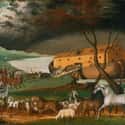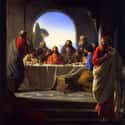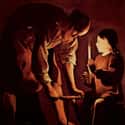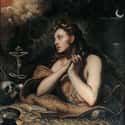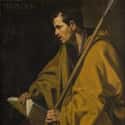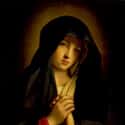-
(#1) In The 'Hypostasis Of The Archons,' Noah's Wife Burns Down The Ark
Noah's wife is unnamed in the Bible, but in the Gnostic gospels she is called Norea. She is Eve's first daughter and has special knowledge and powers. In the Gospel "Hypostasis of the Archons," Norea is a key player in the drama of Noah's ark.
When Noah is first charged to construct an ark, Norea argues against it. In this gospel, God decides to end mankind not because humans are wicked but because they're growing too wise and God is jealous. Norea objects to the idea of the ark and eventually conspires to burn it down.
Noah rebuilds the ark, and Norea is targeted by the forces of evil, which are bent on sexually assaulting her. At the last minute, she calls out to God, who sends an angel to protect her.
-
(#2) The 'Apocryphon Of John' Claims Adam And Eve Were Not Material Beings
Many Gnostic texts focus on cosmology. They tend to feature sweeping hierarchies of gods, angels, and archons (malevolent beings that oversee the material world), with each occupying a distinct place in the Gnostic pantheon.
In the "Apocryphon of John," this extends to Adam and Eve: They are represented not as flesh-and-blood humans created by God, but as manifestations of psychic energy. Before Adam even appears, God fuses together several abstract concepts, such as foreknowledge, indestructibility, and truth, to help him create Adam. When Adam is finally created, it is as a psychic manifestation of these concepts.
-
(#3) The 'Gospel Of Peter' Features A Talking Cross At Jesus's Resurrection
The Gnostic "Gospel of Peter" generally agrees with the traditional Gospels of Matthew, Mark, Luke and John, but it also features some truly odd additions regarding Jesus's demise and resurrection.
First, Jesus is taken from the cross by two large angels, including one whose head "reached unto the heaven." Jesus himself is described as being even larger, his head towering over the clouds. But that's not even the strangest thing. A booming voice then calls out from the heavens, "Thou hast preached to them that sleep."
And the cross itself answers, "Yea."
-
(#4) The 'Hypostasis Of The Archons' Discusses Sophia, Another Creator Who Inhabited Eden's Serpent
The "Hypostasis of the Archons" literally means "the reality of the rulers." It includes an array of spiritual entities, including another creator, Pistis Sophia, an incorruptible celestial force who seems to be a kind of distant consort of God. Indeed, she is so central she is called the "female spiritual principle."
In this Gnostic text, Sophia takes the form of the serpent in Eden and approaches Eve. Sophia convinces Eve to eat the fruit of the tree, causing her expulsion from paradise. After she is done speaking to Eve, the spirit of Sophia abandons the snake, causing it to collapse on the ground.
-
(#5) The 'Gospel Of Judas' Claims Jesus Asked Judas To Turn Him Over To The Authorities
Judas Iscariot's betrayal of Jesus for 30 pieces of silver is a defining moment in the canonical gospels. Judas's sin is considered so great that Dante Alighieri, in his seminal poem Inferno, places Judas not only in the lowest circle of hell but in the eternally gnawing maw of Lucifer. However, in the "Gospel of Judas," Jesus's arrest at Gethsemane is given a completely different interpretation.
This gospel claims its source to be one-on-one conversations with Judas himself. According to the text, the historical ill-treatment of Judas is entirely uncalled for, as he was working for Jesus all along. In this version of the story, the betrayal was planned.
To free himself of his human body, Jesus chooses Judas, his closest friend, to set him up for the Romans. For the sake of his friend, Judas sacrifices himself and his reputation for all eternity.
-
(#6) In The 'Infancy Gospel Of Thomas,' Jesus Causes A Young Boy To Wither Away
This Gnostic text describes a story from Jesus's youth. One day, while playing near a brook, Jesus makes a series of little pools and molds 12 sparrows out of clay. Because it is the Sabbath (when Jews are prohibited from doing work), another child uses a stick to break up Jesus's pools of water, ruining his game.
Now, the canonical Jesus would likely take this in stride and forgive the boy. But this is a much younger Jesus, with a child's temperament. Instead of forgiving his playmate, Jesus says, "O evil, ungodly, and foolish one, what hurt did the pools and the waters do thee? Behold, now also thou shalt be withered like a tree." The boy then withers up and expires.
-
(#7) The 'Second Treatise Of The Great Seth' Claims Someone Took Jesus's Place On The Cross
The "substitution hypothesis" is one of a number of theories that attempt to scientifically explain the resurrection of Jesus. According to this theory, another person was substituted for Jesus before he was crucified, often said to be named Simon.
In the "Second Treatise of the Great Seth," Jesus is indeed replaced by a man named Simon. In this version of events, Jesus is not only fine with sending an innocent man to his doom, he thinks it's funny. He is quoted to say:
Yes, they saw me; they punished me... They struck me with the reed; it was another, Simon, who bore the cross on his shoulder. It was another upon Whom they placed the crown of thorns. But I was rejoicing in the height over all the wealth of the archons and the offspring of their error, of their empty glory. And I was laughing at their ignorance.
-
(#8) The 'Testimony Of Truth' Says God Caused The Fall Of Humanity Out Of Jealousy
There's a lot in the "Testimony of Truth" that contradicts the Bible. This is to be expected from a text about the Garden of Eden written from the point of view of the Serpent; it suggests God is the real enemy of mankind.
The narrative takes place much as it does in the Bible: The serpent tempts Eve, Eve tempts Adam, Adam eats the fruit, and God casts them out of the Garden of Eden. However, the author of the "Testimony of Truth" then indulges in some editorial speculation:
But what sort is this God? First he maliciously refused Adam from eating of the tree of knowledge, and, secondly, he said "Adam, where are you?" God does not have foreknowledge? Would he not know from the beginning? [...] But these things he has said to those who believe in him and serve him!
The author targets God, calling him a "malicious grudger," and accuses the deity of causing the fall for no other reason than jealousy.
-
(#9) In The 'Gospel Of Mary,' Mary Is Jesus's Most Trusted Apostle
Mary Magdalene is conventionally understood to have been a kind of holy groupie to Jesus, and mistakenly believed to be a former prostitute (there is no evidence of this in the canonical Bible). In the "Gospel of Mary," however, Mary herself is an apostle of Jesus who received special teaching and instruction.
After Jesus returns from the afterlife and ascends to heaven, the other apostles are grief-stricken. They ask Mary what Jesus told her in their special instruction. Rather than tell them that, Mary tells them of a vision of Christ she had earlier that day.
Much of the substance of this gospel remains lost. However, after Mary finishes relating her vision, the others argue about whether or not to believe her, with Peter being the most skeptical. However, an apostle named Levi shames Peter and they all agree to go out and preach this new vision to the world.
-
(#10) In The 'Apocalypse Of Adam,' A Figure Called The Illuminator Is Predicted To Defeat God
The "Apocalypse of Adam" is a prophetic text in which Adam tells his son Seth about a vision he has had of the end times. In this vision, a strange figure called the Illuminator, who is responsible for man's expulsion from the Garden of Eden, will arrive and perform many great miracles.
This will attract the attention of God, who will seek out the origins of the Illuminator and eventually meet him in battle. The Illuminator, sometimes also called the seed, will triumph against God, who is also referred to as "the powers."
-
(#11) Young Jesus Slays Another Boy For Bumping Into Him In The 'Infancy Gospel Of Thomas'
The "Infancy Gospel of Thomas" covers a period of Jesus's life largely ignored by the canonical gospels: his childhood and upbringing. However, even the most forgiving Christian would have a problem with the depiction.
In the "Infancy Gospel," Jesus is powerful even as a child, but he does not always use that power to do good. At one point, he is walking through the village and a young boy bumps into him. Rather than shrug off the misunderstanding, Jesus says, "Thou shalt not finish thy course," and the boy falls dead on the spot.
Unfortunately, that's not the end of it. After the boy's parents complain to Joseph, Jesus strikes them blind.
-
(#12) The 'Gospel Of Thomas' Implies Thomas Was Jesus's Twin Brother
Whether Jesus had siblings or not is a matter of debate among Catholics and Protestants. Some Protestant faiths believe Jesus had several siblings, or at least one brother, James. Catholic doctrine has generally held that Mary was a virgin her entire life, and any siblings of Jesus mentioned in the Bible were descended from Joseph by a previous marriage. The "Gospel of Thomas" states Thomas was not only Jesus's brother, but also his twin.
The opening lines of the gospel say, "These are the secret words which the living Jesus spoke, and the twin, Didymos Judas Thomas wrote them down." This is not subtle, as Thomas and Didymos mean "twin" in both Hebrew and Greek, respectively. It's akin to saying, "This is the gospel written by a twin whose name was Twin Judas Twin."
If Thomas was Jesus's identical twin, it lends some weight to the substitution hypothesis (which says Jesus was substituted for someone else and never actually perished on the cross), as well as adding a new dimension to the story of Thomas doubting Jesus's passing.
-
(#13) The 'Gospel Of Philip' Says That Mary Was Never A Virgin Because The Holy Spirit Was A Woman
The "Gospel of Philip" lays out a simple and forceful case against it. It claims the Holy Spirit is a female entity, stating:
Some said, "Mary conceived by the Holy Spirit." They are in error. They do not know what they are saying. Whenever has a female been impregnated by a female?
The "Gospel of Philip" is not the only Gnostic text that believes the Holy Spirit is female. In the "Gospel of Thomas," Jesus calls the Holy Spirit "mother." It's worth noting that early translations of the Bible also refer to the Holy Spirit with a feminine noun. It's likely many pseudo-Christian traditions included a female Holy Spirit because most pagan pantheons included a central male and his consort, like Zeus and Hera, or Odin and Frigg.
-
(#14) There Are Many Different Versions Of The Apocalypse
In the Gnostic gospels, there are many visions of the apocalypse. There is also a kind of apocalypse depicted in the "Gospel of Judas," and that may be the most terrifying of them all.
According to the "Gospel of Judas," humanity is treated like chattel by powerful beings called "archons" that rule the material world. In this cosmology, Jesus is an "aeon," an incarnation of the true spiritual creator of the universe.
Jesus comes down to Earth to open the eyes of mankind and free them from their slavery. He sets Judas up to betray him so that he will be freed from his physical form. However, by performing this sacrifice, Judas turns humanity over to the other apostles, who are archons. This means that nothing changes. Jesus's mission is thwarted and mankind returns to slavery, in which they will remain.
New Random Displays Display All By Ranking
About This Tool
In the Old Testament, the Bible tells us that God’s instructions are delivered through individuals called prophets. The stories of these key prophets like Moses and Noah are famous, and some other prophets may also be very unusual characters. The Bible contains classic stories and individuals that most Christians have heard since childhood, including David and Goliath, Noah and Ark, and Jesus healed the blind. But in the Bible, many stories are obscure, dramatic, and very strange.
Over the centuries, the Bible has had many different versions and interpretations, and even translations in various languages, which can easily lead to misunderstandings. The random tool shares 14 controversial versions of popular Bible stories.
Our data comes from Ranker, If you want to participate in the ranking of items displayed on this page, please click here.











